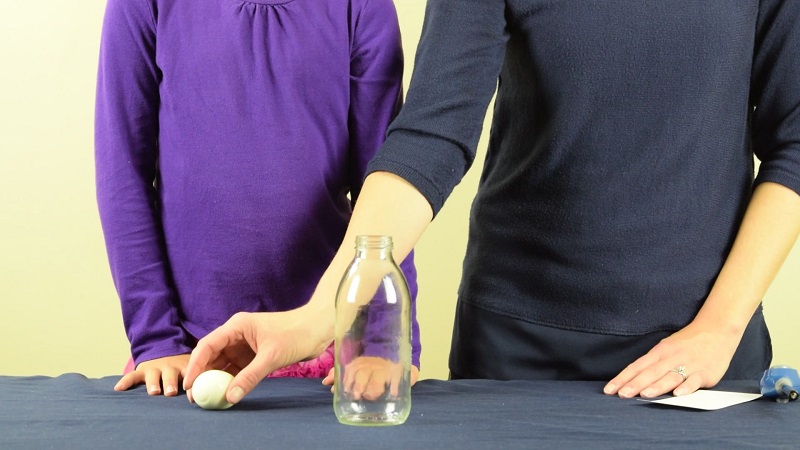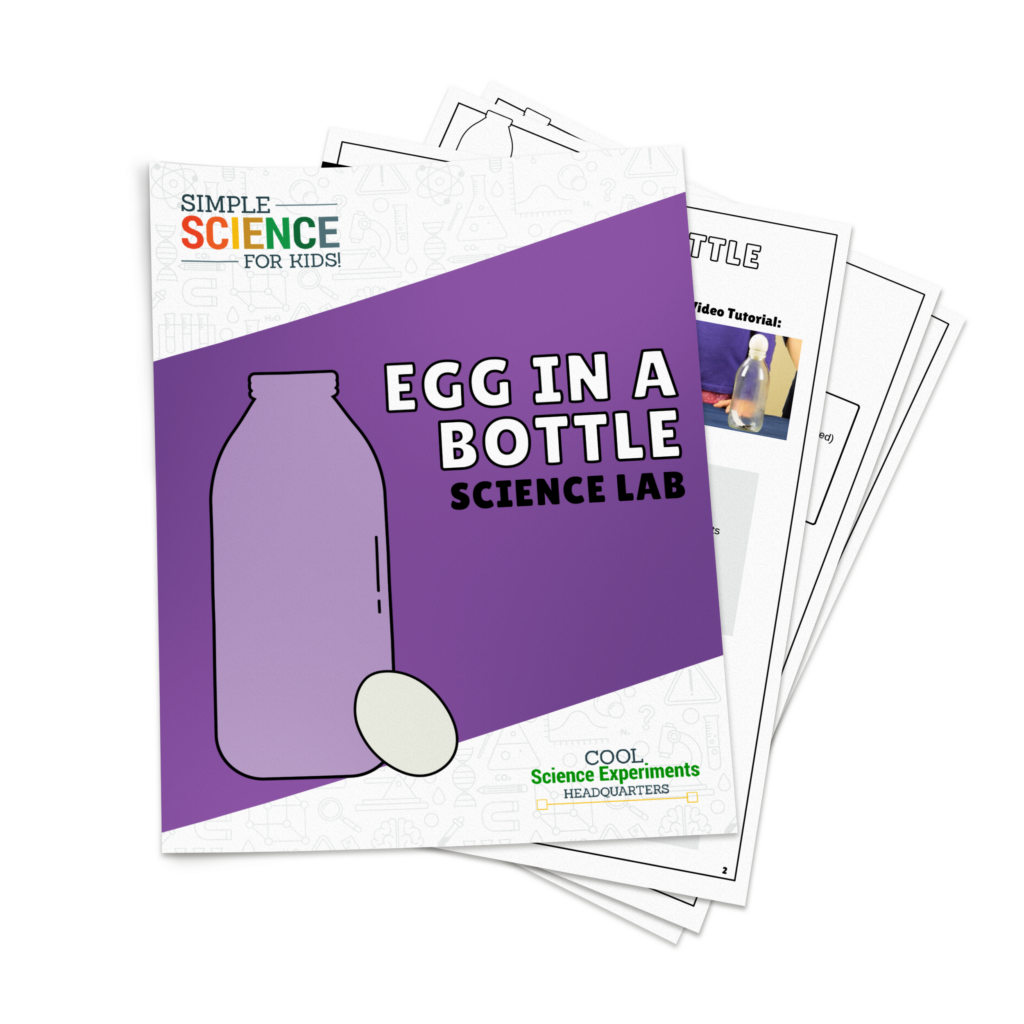Can eggs move by themselves? Maybe not, but with the help of air pressure, they can be pushed into a glass bottle without being touched!
In this experiment, your young scientists will learn about density and air pressure. And when you watch our demonstration video, you’ll see that although things didn’t go exactly as we expected, this experiment is always fun and educational. Printable instructions and a materials list are included.

JUMP TO SECTION: Instructions | Video Tutorial | How it Works
Supplies Needed
- Hard-Boiled Egg (shell removed)
- Glass Bottle
- Thick Piece of Paper
- Match or Lighter
Safety Note: Because the experiment involves fire, adult supervision is required.
Egg in a Bottle Science Lab Kit – Only $5
Use our easy Egg in a Bottle Science Lab Kit to grab your students’ attention without the stress of planning!
It’s everything you need to make science easy for teachers and fun for students — using inexpensive materials you probably already have in your storage closet!
Egg in a Bottle Science Experiment Instructions

Step 1 – Remove the shell from the hard-boiled egg and place it on the mouth of the jar. Take a moment to make some observations. Why doesn’t the egg fit into the jar? Do you think it is possible to put the egg inside the jar? Do you think it is possible for the egg to move into the jar without touching it?

Step 2 – Remove the egg from the jar and set it on the table nearby. Make sure that you place it within reach because you’ll need to move quickly once it’s time to place the egg on the bottle again.

Step 2 – Get your strip of thick paper ready. Note that using thick paper is important because you need something that won’t burn too quickly when you light it on fire. We tore off a piece from an index card. Construction paper would also work nicely.
Carefully use a lighter to light the piece of paper on fire. Safety Note: Remember to always use safety measures when dealing with fire. Adult supervision is required.

Step 4 – Once the paper is burning, carefully but quickly drop it into the glass bottle.

Step 5 – Immediately after you put the paper in the bottle, place the egg on the top of the bottle.

Step 6 – Watch as the egg begins to slowly move into the bottle. If you are lucky the egg will stay in one piece as it moves into the bottle. Or if you are like us, the egg will eventually split as it is squeezed into the mouth of the bottle. Watch the Egg in a Bottle Experiment Video Tutorial to see what happens to our egg.
Were you surprised when the egg began to move into the jar? Do you know why it did? Read the how does this experiment work section before to find the answer.
Egg in a Bottle Science Experiment Video Tutorial
Egg in a Bottle Science Experiment Video Tutorial
How Does the Experiment Work?
Air has mass, so it has other properties like pressure and density. Air is able to push or crush objects when given the opportunity. We don’t often see air pushing or crushing objects because air molecules surrounding objects push on objects equally in all directions. In this experiment, you get to see the power of air!
Air pressure is the reason the egg moves into the bottle without us touching the egg. Let’s go over exactly what happened.
When we started the experiment, the air pressure inside the bottle was the same as the air pressure outside of the bottle because the air inside the bottle and outside the bottle was the same temperature.
After we placed the burning paper in the bottle, the air inside the bottle began to heat up and expand. A few seconds after we placed the egg on top of the bottle, the fire went out and the paper stopped burning. This caused the air inside the bottle to cool down and contract.
When the air contracts, the air pressure inside the bottle becomes less than the air pressure outside the bottle. This gives the higher air pressure outside of the bottle the opportunity to push the egg down into the bottle.
Egg in a Bottle Science Lab Kit – Only $5
Use our easy Egg in a Bottle Science Lab Kit to grab your students’ attention without the stress of planning!
It’s everything you need to make science easy for teachers and fun for students — using inexpensive materials you probably already have in your storage closet!
I hope you enjoyed the experiment. Here are some printable instructions:

Egg in a Bottle Science Experiment
Materials
- Hard Boiled Egg (Shell Removed)
- Glass Bottle
- Thick Piece of Paper
- Match or Lighter
Instructions
- Position the egg near the empty bottle. This is needed because you have to move fast once it is time to place the egg on the bottle.
- Take a strip of thick paper. Think paper is important, because you need something that won’t burn too quickly when you light it on fire during the next step. Helpful Tip: I used a piece of index card. Construction paper would also work nicely.
- Light the piece of paper and drop it into the bottle. Remember to always use safety measures when dealing with fire.
- Once the paper is burning, carefully but quickly drop it into the glass bottle.
- Immediately after you put the paper in the bottle, place the egg on the top of the bottle.
- Watch as the egg begins to slowly move into the bottle. Helpful Tip: If you are lucky the egg will stay in one piece as it moves into the bottle. Or if you are like us, the egg will eventually split as it is squeezed into the mouth of the bottle. Watch the Egg in a Bottle Experiment Video to see what happens to our egg.



Leave a Reply